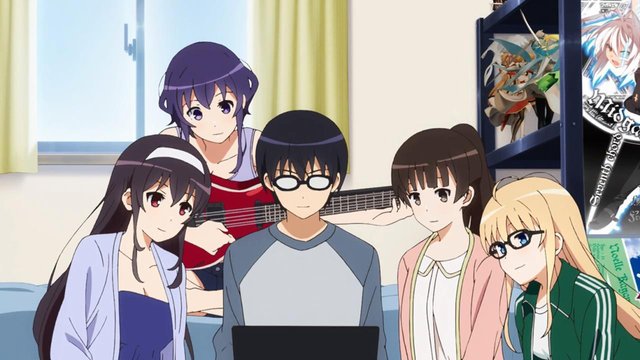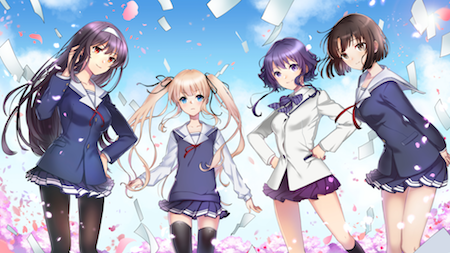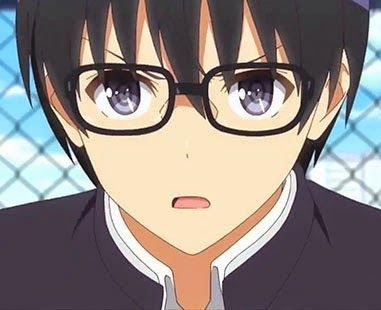Saekano: How to Raise a Boring Harem
Saenai Heroine no Sodatekata is an anime all otaku can resonate with. Season 1 follows the ups and downs of a high school indie game development group, with a mix of humour, harem hijinks and character interplay. Season 2 exchanges the humour for drama, with interpersonal tension and conflict threatening to tear the group apart. With its mix of superb voice acting, characterisation and production values, Saekano is an excellent piece of entertainment – if you don’t think too hard about the relationships.
This is not a review. There are plenty of reviewers who can do a better job than me. Instead, I’m going to write how Saekano is emblematic of everything wrong with modern harem anime.
The Boring Harem

Just a high school boy and his groupies, nothing to see here
Saekano is centred on Aki Tomoya, a Japanese high schooler who happens to be a diehard otaku. Right off the bat, you can tell who the anime is aimed at: like many high school otaku of his breed, Aki is the audience stand-in, distinguished by his undying love for all things otaku—light novels, anime, manga, video games—and his utter obliviousness to emotions.
One fine day, while Aki is cycling home, he sees a beret floating down a slope. As cherry blossoms swirl around him, he looks up to see a girl at the top of the slope. The encounter inspires him to create the perfect dating sim. Returning to school, he discovers to his complete shock that his classmate, Kato Megumi, was the girl he met.
Aki ropes Kato into his project, and quickly enlists his friends (naturally, all girls) to help out. The team artist is Sawamura Spencer Eriri, Aki’s half-English childhood friend, who also creates adult-themed art for a famous doujin group Egoistic Lily. Third-year student Kasumigaoka Utaha, in reality a bestselling author who writes light novels under the pen name Kasumi Utako, handles the script. Later in the first season, the anime introduces Hyodo Michiru, Aki’s cousin-cum-other childhood friend who plays in the band Icy Tail, as the music composer. Together, they form the doujin circle Blessing Software.
We see here the essential ingredients of a Japanese high school harem anime. First, there is a male otaku main character with the emotional intelligence of a rock. Second, a bunch of girls who for some inexplicable reason are attracted to him. Third, a joint endeavour that demands all of them to work together.
If Aki resolves the romantic conflict by choosing any of the girls, it would end the primary source of tension, humour and drama within the series – and, quite likely, end his life. Every girl except Kato (maybe) is motivated by romantic intentions, so if any of them are forced to give up on him, it’s quite likely they will quit the group. Thus, the story demands that the harem situation be strung out indefinitely, even well past the point of unrealism.
This is the primary pitfall of harem-type fiction where the harem members are motivated primarily by amorous intent: the second the romantic conflict is resolved the whole cast, and thus the story, must fall apart. To keep the story going, the MC must remain an idiot into eternity and the harem’s character development must centre on their relationship with the MC.
Of Stereotypes and Romance

Go on, guess who's the normal one
Saekano sets itself apart from other harem stories by making half of the female cast otaku. When placed side-by-side with the non-otaku, the audience can see a sharp contrast in their personalities and how their hobbies and lifestyles influence their behaviours.
Unfortunately, the show confines these characters to their archetypes instead of doing much about them.
Sawamura is the classic tsundere: blonde, twin-tailed, slightly shorter, zettai ryouki stockings, and prone to violently abusing Aki at the drop of the hat. She defined her entire relationship with him based on being childhood friends, having gone to the same elementary school as him. They fell in love with the same works together, be they dating sims, light novels or anime. However, their elementary school classmates started insulting and shunning Aki for being an otaku, and fearing the same treatment, she began to hide her otaku self and distance herself from Aki. Even though they still talk otaku stuff, their relationship is clearly strained. This becomes the focal point of her story arc in the anime.
Kasumigaoka is a yandere without the murderous intent…probably. They first met at a book signing, when Aki recognised her as his senior. Eventually they started talking intensely about her books, with him praising them to high heaven and starting a fan site that single-handedly accounted for a significant fraction of its sales. While she acts cold, sarcastic and domineering most of the time, she is also highly obsessed with Aki and will manipulate everyone around her to get time alone with him. She is the most aggressive among the girls, and can match Sawamura for jealousy. Many of the show’s comedic beats come from her verbal sparring with Sawamura and her cutting remarks, but her arc is focused on her trying to express how she feels about Aki through her work.
Through their portrayals, Saekano displays a stunning lack of understanding about romance. Shared hobbies are the basis for friendship. It can graduate to romance, but it needs more than what is portrayed on-screen.
In Kasumigaoka’s case, we see Aki chatting excitedly about her work and later helping her with her writing. This is functionally no different than the relationship between superfan and author, and then editor and author. As a bestselling author, Kasumigaoka would have received similar praise from other fans, and she works with an editor to produce new stories. Aki doesn’t offer anything beyond that.
As for Sawamura, it’s shown that she and Aki spent lots of time together reading the same books, playing the same games and discussing the same fiction. But nothing else. They don’t do much more than that, and we don’t see them trying to talk about stuff other than the otaku culture. Sure, Aki may celebrate and promote her work enthusiastically—but that is simply who he is, and as an artist of a renowned doujin circle she would also receive similar praise for her work from her other fans.
To be perfectly cynical about this, the girls’ feelings for Aki reflect a distorted image of romance: that obsessing over common hobbies and interests will lead to someone falling for you. That is simply not true. You need trust, emotional intimacy and overall compatibility, and throughout the show there are no indications of any of this between Aki and the girls.
Why would Sawamura and Kasumigaoka fall for him and act the way they do? Just because he is a superfan? Because they have similar interests? This is the basis for friendship, not romance. Romance demands both sides to get closer than that, and that emotional closeness is simply lacking.
Hyodo’s motivation is even more suspect. She and Aki were born on the same day at the same hospital, and they played together a lot as children. Eventually she moved away, enrolling in an all-girls’ school and joining a band. When she meets him again, though, she acts overly-familiar with him, deliberately dressing skimpily and clinging to him whenever she can. She is not herself an otaku, so she doesn’t even have the excuse of having a similar hobby, and they aren’t so close that Aki immediately thinks of her when putting together his circle. She is flighty and whimsical, but it’s hinted that she has feelings for him.
But why?
Her presence in the show basically serves two purposes: to throw Sawamura’s identity as Aki’s childhood friend into disarray, and to satisfy the disturbing Japanese obsession with cousin romances. There is neither rhyme nor reason for her to act the way she does with Aki, unless she were either toying with him or genuinely interested in him, and the show doesn’t make it clear either way. While they were close as children, such childhood experiences do not translate into shared intimacy as teenagers; indeed, after she moved away, Aki doesn’t even mention her until her it’s time for her arc. Throughout both seasons, Hyodo enjoys the least character development among the main cast, and her feelings for Aki remain as nebulous as her heart.
Throughout both seasons of Saekano, there’s only one character with whom Aki shares a quantum of emotional development: Kato Megumi, the titular boring girlfriend. It’s clear from the start that she’s meant to win his affections. As a non-otaku she isn’t read into the culture, but she begins to enjoy the process of making games. As the heart of the circle, she helps to mediate conflicts and keep everyone on task. True to her epithet, she is very reserved and has little outward expression. This sets her apart from the rest of the cast’s exuberance, and when she finally displays a wider range of emotional affect in Season 2 you can tell she is warming up to Aki. She is the only normie in the entire cast and, in a realistic setting, quite likely the only person for whom he would even have a snowball’s chance in hell of having anything resembling a romantic relationship with.
Our Hero, the Masochistic Idiot

Otaku intensifies
Aki is an idiot.
Let’s examine his relationships with Sawamura, Kasumigaoka and Hyodo. What do they have in common?
Violence.
Again and again and again, the girls’ first response whenever they feel jealous or angry or embarrassed is to take it out on Aki. Sawamura smacks him all the time. Kasumigaoka alternates between acting scary and acting out. Hyodo reveals her secret passion for wrestling. Somehow, this is supposed to be hilarious.
It’s not.
Firstly, it’s predictable. Casual female on male abuse has been an anime and manga staple since well before I got into the scene. Whenever Aki trips up (read: all the time), you can expect a girl to lash out at him. The outcome is already guaranteed; the only question is how she, or they, will do it. By being predictable, it becomes eye-rollingly stale.
Secondly, why doesn’t Aki walk away? The violence is always out of proportion to what he did. He may simply be a high schooler, but why would he consider girls who routinely abuse him as his friends and co-workers? We don’t see the violence affecting him or his relationships with the girls; it’s almost as if it’s just some kind of harmless quirk that can be laughed off.
I can’t buy this. Abuse and violence poisons relationships, and a show that aspires to be a drama must capture this.
Abuse aside, I find it unbelievable that Aki can be so oblivious to emotions. He isn’t some random otaku; he is explicitly portrayed as a fan of dating games and romance novels. Instead of learning from them, however, he plays out the dense protagonist stereotype to a T, and continues to do it even though associating with the girls leads to emotional and physical violence. That makes him completely predictable and utterly boring—the only difference between him and other similar otaku MCs is his over-the-top reactions. It takes Aki most of two seasons before he finally wises up.
Despite his lack of emotional maturity, the girls still flock to him anyway. Because, well, harem. He doesn't display any sign of romantic interest in the girls, nor does he display any attractive qualities. Only in Season 2 do we finally see Aki coming to grips with his immaturity…and even so, there will still be a harem if Season 3 ever comes around.
A Foundation of Sand
This isn’t to say that Saekao is unsalvageable. If anything, it’s remarkable how well the anime played out in spite of its shaky foundations. It remains true to the tenets of storytelling, marked by steady character development and its insights into the doujin industry. However, it asks the audience to accept as given the girls’ feelings towards Aki instead of diving in depth into them, and this as a creator I cannot do.
Giving every girl a romantic interest in the MC, and thus a personal stake in events, is an extremely tricky situation. If I were the creator, I would have gone on a different tack, even changing sexes if necessary.
The artist would be motivated by a desire to heal the rift between her and the MC once and for all, and take the opportunity to create work more meaningful than mere pornography. The writer joins the circle because she feels obligated to the MC for her success, and from a professional perspective, she wonders if she can do more than just light novels. The musician may not be an otaku like the MC, but she thinks it’s a chance to reconnect with her long-distant cousin and for her band to hit the big time.
By taking away romance and combining professional ambitions and personal motivations, Saekano becomes more than a high school harem. It becomes the story of young creators seeking to be greater than they are while grappling with puberty and emotions, with Aki providing the spark and the platform for their future. In this light, even if Aki picks any of the girls, the story can still proceed apace. In fact, other than the titular boring girlfriend, they don’t even need to be girls.
And, done right, you won’t need a boring harem.
I need to ignite my harem anime feels again.
The last harem i watched was Campione. ;)
I've been told Tenchi Muyo is unparalleled in the field of harem anime.
I really haven't seen that anime.
I will check that out later. :)
If you like Tenchi and want to see a simple and comprehensive site explaining the series I run a website that is the best in the fandom.
https://tenchimuyotranslationblog.blogspot.com/
I'm actually the Tenchi fandom's translation guru Fap_Fapperson.
I've graphed and charted the series and google translated/Sumerized all the novels and worked on the translations for a few of the Doujinshi. If yo like tenchi check it out and check out uselesstenchi.org where i post my latest work before i update it to the site.
Upvoted and also resteemed :]
Thanks!
Love this title - anime awesome. Ty for the review.
But also should be considered these are Japanese relations, where understatement and ambiguity are valued. Aki is not exactly an idiot. He understands everything. I think he believes he is not worthy of his brilliant friends.
Thanks. While Aki hints that in Season 1 he isn't that big of an idiot, it seems like he dropped the idiot ball in Season 2. He made a couple of major blunders, forcing the team to give up their original deadlines and tearing the circle apart. I found that really odd, since he had an hours-long car drive to calm down and make the necessary arrangements to ensure the project remained on track.
The last complex explanation I can think of is that Aki is your typical harem MC: he's an idiot when drama demands it.
well yes nothing to be done about. :D
"Aki resolves the romantic conflict" Man I cannot solve my romantic conflict to save my life! This is a quality blog you have when did you start writing this good?
Thanks! It's just a matter of practice and hard work over the years.
Harem anime? Dating sims? Clearly there is a lot going on in Japanese culture that I know nothing about.
I wonder how much of this entertainment gets incorporated into day-to-day life. Do the Japanese really date this way? Do they look to dating sims as practice for how to conduct their real relationships? Are the unrealistic expectations about relationships contributing to the Hikikomori culture of shut-ins that we read about? And could the female on male abuse be "fair play" revenge for the misogynistic attitudes portrayed in hentai and "fan service?"
I know that as an old, American outsider I'm being particularly obtuse about this. But we see these exports of Japan's entertainment industry while never experiencing anything of its actual living culture, and I can't help but feel curious about how one influences the other.
Japanese culture is a strange wonderland filled with bizarre phenomena impenetrable to most outsiders. I really don't know how much Japanese dating sims mimic Japanese dating culture, beyond the emphasis on Japanese-style etiquette, confessions of feelings, and Japanese high school or university culture for sims set in those settings.
Female on male abuse seems to be fanservice and a staple of certain anime personality archetypes, though I don't know if it's fair play for portrayals elsewhere.
What I can say is, having visited Japan once, the anime and manga visual aesthetic seems to be everywhere. As to how far behaviours and ideas in anime and manga influence local culture and norms or vice versa, though... I can't say for sure.
It sounds like this would be a great topic for a masters or doctoral thesis! Thanks for taking the time to share your experience.
Thanks for dropping by!
This sums up everything I don't like in these animes, some of them has good stories otherwise (like SAO)... well, it's Japan, and Otaku are those who pay... so why not give them.... "quick" dreams?
The best anime were the ones that delivered incredible stories and characters without pandering to otaku (too much). I'd like to see more of those and less of otaku bait.
I totally agree.... even SAO would've been better without its "Harem" parts.